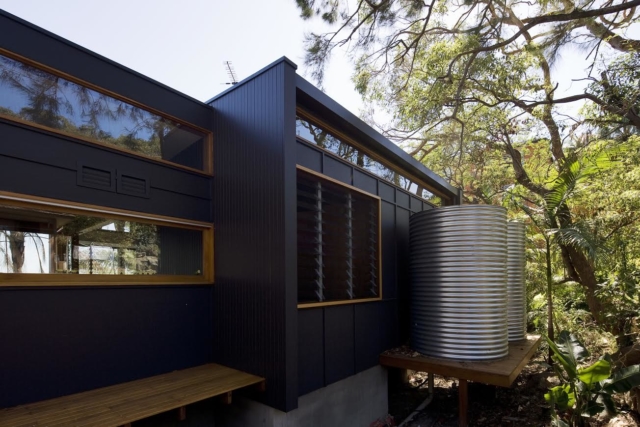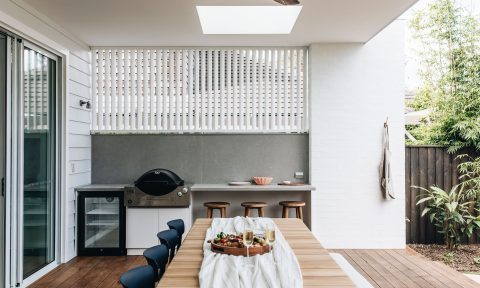By Laney Clancy
What is sustainable renovation? Here is our guide to sourcing eco-friendly materials, selecting energy and water-saving products, and creating environmentally sustainable spaces.
Sustainability is more than a buzzword, it’s a way to be resourceful and create long-lasting changes for the better. Being aware of environmentally sustainable products and practices when you renovate can reduce your carbon footprint, help you decrease energy and water usage and give you long-term financial savings.

What is sustainable renovation?
In this context, sustainability is reducing our impact on the environment. Sustainable renovation is the practice of using materials and products that maintain ecological balance through form and function.
Sustainable materials may include recycled surfaces such as reclaimed timber, secondhand fixtures and eco-friendly choices of certain products, such as paints and tiles. You may also choose to install products that will assist energy and water saving, such as LED lighting and appliances with good energy ratings, plus low-flow showerheads and water-saving toilets.

1. Choose sustainable materials
Sustainable materials are those that come from a replenishable source or have been reused, repurposed or recycled.
Timber from old growth forests is not sustainable; compare this with plantation timber or reclaimed wood. The benefit of reclaimed or recycled wood is its beautiful weathered look and sense of history. Don’t forget you’ll need to treat the wood to protect it from rotting and this substance should also be eco-friendly.
Your choice of material may dictate the aesthetic of your renovation or vice versa, but fortunately there’s a big enough range to fit into a lot of different themes. Reclaimed pieces can be used for retro chic, rustic or industrial looks, for example, or it can shake things up in a modern home.
Consider also the volatile organic compounds (VOCs) content in the materials you select. VOCs are chemicals containing carbon that evaporate into the atmosphere and unfortunately little is known about the health hazards. Low or zero VOC paints, urethanes and particle boards are all available, albeit at a higher cost.
Other materials you might consider include recycled plastic and laminates as well as glass and ceramic, both of which can be recycled.

2. Aim for efficiency
The bathroom, kitchen and laundry are the three areas where we tend to use the most energy and water so when you’re in the market to purchase fixtures, fittings and appliances for these rooms, make efficiency a key criterion. Not only will this reduce the resources you use, it will save you money in the longer term as well.
Energy star ratings and water ratings (WELS) are a good start but even before you buy items, think of how you can reduce or eliminate the need for them. Creating a temperate environment within the home through good insulation (including to insulate your water pipes) and ventilation will reduce the need for air conditioning and heating. Having a lot of natural light may reduce your reliance on lighting.
Efficiency in heating and cooling also applies to water. A continuous flow hot water system, for instance, will heat water when you need it, whereas a tank system uses energy all day by heating water in the tank whether or not you’re using it. Keep in mind that what a continuous flow system saves on energy it can waste in water as you wait for the water to heat up and reach the outlet. So choose a water wise unit or install a recirculating pump.
If you want to go a bit further, installing green spaces, such as vertical gardens or a green roof, can also support insulation as well as improve air quality.

3. Future-proof your home
You can use your renovation to future-proof your home in two ways. The first is by preventing unnecessary repairs in the future, for example leak-proofing your house by checking gutters and the roof and undergoing proper waterproofing for wet areas such as bathrooms and the laundry to prevent damp.
Secondly, you can install sustainable features—or plan for them if you cannot afford to include them now. Some ideas include:
- Rainwater tank to capture clean rainwater. Instead of going down the drain you can use rainwater on the garden or to flush your toilet.
- Greywater recycling takes soapy water from washing machines and basins for use as above.
- Solar panels and a set of home batteries like the Tesla Powerwall will store the sun’s energy. It’s possible to live ‘net zero’ (no more electricity bills!) but have the security of being connected to the grid if you ever need it.
- Roof colour is often overlooked as a way to reduce energy usage. Dark colours can absorb up to 90% of the sun’s radiant heat—fantastic in a cold climate but uncomfortable if not. Studies show that a white, mid-grey, or steel roof can have approximately 30% lower heat gain than a dark roof.
Don’t forget to see what rebates, buy-backs and other incentives are available for sustainable practices.
Lastly, make sure the people you hire demonstrate sustainable practices too. There are certifications for professions such as plumbing that will help you discern practitioners. A certified Enviroplumber, for example, completes six years of training to become a qualified plumber, drainer and gasfitter and has additional training in sustainable plumbing practices such as installing rainwater tanks and fixing solar hot water systems, as well as abides by the Enviroplumber Code of Practice.
With these considerations in mind you’ll be well on your way to creating a sustainable home.
Laney Clancy is the marketing and finance Manager at Pipe Perfection Plumbers in Sydney. She is married to Darren, the owner of the business, which has a team that includes specialist enviroplumbers and more, servicing the Inner West and Eastern Suburbs of Sydney.









